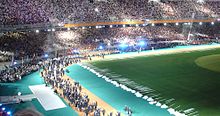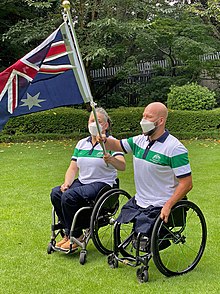Australia at the Paralympics
The first Australian representative was 19 year old Charlene Todman, who had travelled to the hospital due to a lack of suitable care for spinal injuries in Australia at the time, competing in Archery at the 1951 games.
Representatives were also expected to compete in multiple events, with Ross Sutton who had been paralysed in a Tiger Moth crash two years earlier, earning Australia's first Gold Medal in Archery.
[10][11] Australia would send athletes to every subsequent Paralympic Games, including the 1976 Winter Paralympics, although due to the organisers only allowing amputees, blind or visually impaired athletes, Australia's only representative skier Ron Finneran was unable to compete due to childhood Polio having impaired a leg and arm.
[14][15] Host country (Australia) Non team member (SM) [16] Source:[17] Best results in non-medalling sports: Notes:^ Ron Finneran attended and was expected to compete, carrying the flag during the Opening Ceremony, but due to the Paralympics lacking a limb impairment category other than amputee, he was excluded, and instead acted as an official at the games.
[19] With the games in Tokyo, Australia was able to send a large contingent of athletes as a result of the shorter than typical journey.
[20] Lorraine Dodd was an outstanding athlete at these games, setting three Swimming records for her class, all on the same day.
Apartheid practices in South Africa brought controversy with the country's invitation to and inclusion in the games.
Australian athlete, Eric Russell took a stance against politics at the Paralympic Games when he refused his gold medal in the class 3 discus event as a protest.
Australia was represented by one athlete, Ron Finneran; however, he was disqualified as his disability did not meet event classifications.
[24] Australia had two competitors, Kyrra Grunnsund and Peter Rickards, who participated in Slalom and Middle Distance Alpine Skiing respectively.
[28] Australia competed in 16 events, achieving 23 gold medals in three sports, Athletics, Swimming and Lawn Bowls.
The ID Australian men's swimming team was totally dominant in Madrid, with Joseph Walker being the undoubted star winning nine gold medals (five individual, four relay) from all events that him competed and setting two world records.
[31] In the Wheelchair Basketball match, Australia vs Great Britain, Troy Sachs recorded the highest number of individual points scored.
The success of the team combined with extensive media coverage went a long way to changing public attitudes towards Paralympic athletes and understanding them as elite sportspeople.
Sauvage and Tim Sullivan both competed in this games and found outstanding success in their individual events.
Milton becoming the first athlete in his class to claim a clean sweep of gold medals across the four alpine disciplines when he won gold in all four of his events – Downhill, slalom, giant slalom, and super-G.[33][34] At the 2004 Paralympics, Australia was represented by a considerably smaller team than that of the 2000 Summer Paralympics in Sydney; however, ranked second overall medals behind China.
[4] Emily Jansen competed, as Australia's first female competitor at a Winter Paralympics, in two of the four alpine events.
Australia ranked fourth overall behind China, Great Britain, and USA in the gold medal table.
Australia sent their biggest delegation to an away Games to date with 167 athletes, 95 males and 72 females, who competed in 13 out of the 20 sports contested.
[38] Australia had their first Australian female to win a medal at the Paralympic Winter Games, when Jessica Gallagher won bronze in the slalom.
[19] Australia achieved 16 world records and 35 Paralympic Records with performances from such athletes as: Todd Hodgetts (Shot Put), Kelly Cartwright (Long Jump), Susan Powell (Individual Pursuit), Bradley Mark (10m Air Rifle), Brenden Hall (400m Freestyle) and Blake Cochrane (100m Breaststroke).
Jacqueline Freney was the most successful athlete from any nation, winning eight gold medals from eight events while her swimming teammate Matthew Cowdrey became the most successful Australian Paralympian of all-time by winning his 13th career gold medal at his third Games.
[19] Matthew Cowdrey won gold on day seven in Men's 50m Freestyle S9 Final, also breaking the world record which still stands at 25.13seconds.
The Australian wheelchair rugby team won its first Paralympic gold medal after claiming silver at the last two major tournaments (Beijing 2008, World Champs 2010).The youngest competitor in the London Games, 13-year-old & 300 days Maddison Elliott from Newcastle, NSW, claimed one gold, one silver, and two bronze medals and had the pleasure of presenting Prince Harry with Australian's Paralympian toy Mascot “Lizzie” the Frill-necked Lizard.
Australian Paralympic Chief Executive Jason Hellwig said that 'we were absolutely disappointed we didn't get the mission done to win that gold medal', however, he also described it as the most satisfying he had experienced because of the hardship the team had gone through.




















